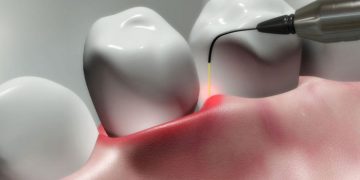Introduction
Cavities, also known as dental caries, are one of the most common oral health issues worldwide. They occur when bacteria in the mouth produce acids that break down the enamel of your teeth, creating holes. If left untreated, cavities can worsen, leading to tooth decay, infection, and even tooth loss. However, cavities don’t just appear overnight. They develop over time, and there are early warning signs that can help you detect them before they become serious. Early detection and preventive care are essential for halting cavities in their tracks, potentially saving you from costly dental treatments and protecting your long-term oral health.
In this article, we will explore the early warning signs of cavities, how to maintain optimal oral hygiene to prevent them, and the dental treatments available for early-stage cavities. By understanding the symptoms and taking action early, you can preserve your teeth and prevent further damage.
Early Signs of Cavities
While cavities develop gradually, there are certain signs and symptoms you can watch for. Recognizing these early warning signals is key to stopping cavities before they progress to more severe stages. Below are some common early signs of cavities:
1. Tooth Sensitivity
One of the first signs of a cavity is tooth sensitivity. You may notice discomfort when consuming hot, cold, or sweet foods and drinks. This happens because the cavity weakens the enamel, making the underlying dentin more exposed to stimuli. Dentin contains tiny tubules that lead to the nerves of the tooth, and when exposed, they can cause sensitivity and pain. If you experience sensitivity that doesn’t go away after a short period, it could be a sign that a cavity is forming.
2. Pain When Chewing or Biting Down
Pain when chewing or biting down can also be a sign of a cavity. When a cavity reaches deeper layers of the tooth, it can affect the nerve endings, causing pain. This pain can range from mild discomfort to sharp, shooting pain when pressure is applied. If the pain persists or becomes more severe over time, it’s important to seek dental care to address the problem before it worsens.
3. Visible Holes or Pits in Teeth
As cavities progress, they may become visible as small holes or pits in the surface of your teeth. These holes are the result of the enamel being broken down by acids from bacteria. While early-stage cavities may not always be visible to the naked eye, more advanced cavities can appear as dark spots or holes, especially on the chewing surfaces or along the gumline. If you notice any unusual discoloration or small pits in your teeth, it’s time to visit your dentist.
4. White Spots on Teeth
Before a cavity forms a visible hole, you may notice white spots on the surface of your teeth. These spots indicate the early stages of enamel demineralization, where the enamel begins to lose minerals due to acid exposure. At this stage, the damage may still be reversible with good oral hygiene practices and fluoride treatments. If you notice white spots, it’s important to take action immediately to prevent the progression of a cavity.
5. Bad Breath (Halitosis)
Bad breath, also known as halitosis, can be an indication of cavities, especially if it’s persistent. The bacteria that contribute to cavity formation also produce sulfur compounds, which can cause an unpleasant odor in the mouth. If your bad breath doesn’t improve with regular brushing and flossing, it could be a sign of an underlying cavity or infection.
6. Discoloration or Dark Spots on Teeth
As cavities progress, they can lead to discoloration or dark spots on your teeth. This is especially common on the biting surfaces and between the teeth, where plaque and bacteria can accumulate. Dark spots can indicate that the enamel has been compromised, and decay is beginning to take hold. If you notice any unusual discoloration, it’s important to have it examined by a dentist.
How to Maintain Oral Hygiene to Prevent Cavities
Preventing cavities starts with maintaining good oral hygiene. By brushing, flossing, and using mouthwash regularly, you can significantly reduce your risk of developing cavities. Below are some key tips for maintaining excellent oral hygiene:
1. Brush Your Teeth Twice a Day
Brushing your teeth at least twice a day is essential for removing food particles and plaque buildup, which are primary contributors to cavity formation. Use a soft-bristled toothbrush and fluoride toothpaste, as fluoride helps remineralize your teeth and strengthen enamel. Be sure to brush for at least two minutes, paying close attention to all surfaces of your teeth, including the chewing surfaces, the outer and inner surfaces, and along the gumline.
2. Floss Daily
Flossing is an important step in your oral hygiene routine, as it helps remove food particles and plaque from between your teeth and along the gumline. These areas are difficult to reach with a toothbrush alone, so flossing ensures that all surfaces are cleaned thoroughly. Be sure to floss gently to avoid injuring your gums.
3. Use Mouthwash
In addition to brushing and flossing, using an antimicrobial mouthwash can help reduce plaque and bacteria in your mouth. Mouthwash also helps freshen your breath and provides fluoride to strengthen your teeth. Choose a mouthwash that contains fluoride to help protect your enamel and prevent cavities.

4. Limit Sugary Foods and Drinks
Sugary foods and drinks feed the bacteria in your mouth, causing them to produce acids that erode your enamel and lead to cavities. Try to limit your consumption of sugary snacks, soda, and sugary beverages. Instead, opt for tooth-friendly snacks like vegetables, fruits, and nuts, which are less likely to contribute to cavities.
5. Drink Plenty of Water
Drinking water throughout the day helps wash away food particles and bacteria in your mouth. It also helps neutralize acids that can damage your enamel. Drinking fluoridated water is particularly beneficial, as it provides additional protection for your teeth. Make sure to drink water after meals to help maintain a clean mouth.
6. Use a Toothbrush with Soft Bristles
Using a toothbrush with soft bristles is essential for protecting your gums and enamel. Hard bristles can damage your gums and wear down your enamel, making your teeth more susceptible to cavities. Make sure to replace your toothbrush every three to four months or sooner if the bristles become frayed.
7. Visit Your Dentist Regularly
Regular dental check-ups are essential for preventing cavities and other oral health problems. Your dentist can detect early signs of cavities, remove plaque and tartar buildup, and provide fluoride treatments to strengthen your enamel. Be sure to visit your dentist for a professional cleaning and examination at least twice a year.
Dental Treatments Available for Early-Stage Cavities
If your dentist detects a cavity in its early stages, there are several treatment options available to stop it from progressing. Early intervention is key to preventing further damage and saving your tooth. Below are some common treatments for early-stage cavities:
1. Fluoride Treatments
Fluoride is a mineral that helps remineralize enamel, making it stronger and more resistant to decay. If your dentist detects early signs of cavities, they may apply a fluoride treatment to help reverse the damage. Fluoride can be applied in several forms, including gels, foams, or varnishes, and is often used during routine dental check-ups.
2. Dental Sealants
Dental sealants are a preventive measure that can help protect the chewing surfaces of your back teeth. Sealants are thin, protective coatings applied to the grooves of your molars to prevent food and bacteria from getting trapped. While sealants are not a treatment for existing cavities, they can help prevent future cavities from developing in the grooves of your teeth.
3. Fillings
If a cavity has progressed beyond the early stages, a filling may be necessary. Fillings are used to restore the tooth after the decay has been removed. Various filling materials are available, including composite resin, amalgam, and porcelain, depending on the location and severity of the cavity. In most cases, fillings can restore the tooth to its normal function and appearance.
4. Root Canals
If a cavity has progressed deep into the tooth and caused an infection in the pulp (the innermost part of the tooth), a root canal may be required. During a root canal, the infected pulp is removed, and the tooth is sealed. This procedure helps save the tooth and prevent the infection from spreading.
5. Crowns
For larger cavities that have caused significant damage to the tooth, a crown may be necessary. Crowns are custom-made caps that fit over the damaged tooth, restoring its shape, strength, and function. Crowns are typically made of metal, porcelain, or a combination of both.
Conclusion
Cavities are a common dental issue, but they don’t have to lead to serious oral health problems. By recognizing the early warning signs of cavities and maintaining a good oral hygiene routine, you can prevent them from worsening and save yourself from more invasive treatments. Early intervention is key, and with the help of regular dental check-ups, fluoride treatments, and other preventive measures, you can protect your teeth and maintain a healthy smile for years to come. Be proactive about your oral health and take the necessary steps to stop cavities before they become a serious issue.













































Discussion about this post